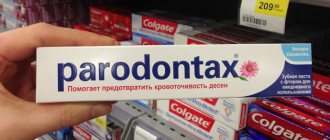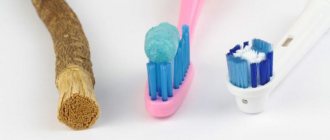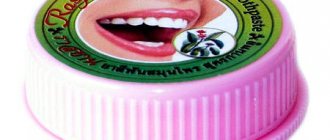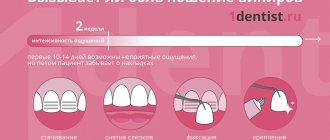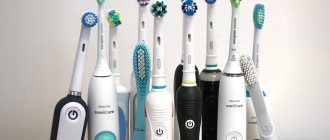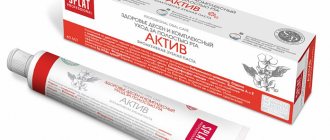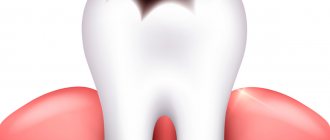From the history
The mention of the first means for cleaning teeth dates back to the 3rd-5th millennium BC. The ancient Egyptians ground eggshells, pumice, ashes of ox entrails, and myrrh and prepared a product from this, which was the progenitor of tooth powder. The Greeks, Romans and Persians improved the recipe by adding shellfish shells ground into powder, crushed chalk, honey, and dried plants. The Slavs contributed to the development of dentistry by starting to brush their teeth with birch charcoal. Powders and pastes, more or less similar to modern ones, appeared in Great Britain only in the 18th century, when their use was considered the prerogative of the nobility.
Modern people are luckier - everyone can choose a product to suit their taste and budget or for medical reasons. Nowadays there are toothpastes that are not only hygienic, but also therapeutic and prophylactic, which include special additives. Let's look at them in more detail.
Hollywood smile. How to whiten teeth at home? More details
Symptoms of enamel destruction
Despite the fact that enamel is very durable, it is vulnerable to many factors. This means that the risk of its destruction and thinning is quite high. Especially in urban environments, where it is not so easy to find quality products, poor environment and a lot of stress.
Deterioration in the quality of enamel leads to serious consequences - it increases the risk of developing caries and other diseases. It is important to remember that although saliva partially regenerates the mineral layer, this is not enough. Restoring the mineral composition requires the use of additional measures.
In different parts of the tooth surface, the thickness of the protective layer is not the same - the closer to the root, the thinner the enamel. The chewing surface, which bears the main load, can have a protective layer of up to 2-2.5 mm. But this does not mean that enamel at the roots is not important. Although this part of the tooth is not subject to much stress when chewing, it is very vulnerable. The spread of microorganisms begins from here. Pieces of food remain under the gums and between the teeth, which creates a good environment for bacteria to multiply and, of course, it is much easier for them to destroy a thin layer of enamel. When this happens, microorganisms no longer have any special obstacles to penetrate deep into the tooth. Therefore, when the enamel is damaged, carious cavities form so easily.
To prevent this from happening, it is important to determine at an early stage that the protective layer is damaged. This can be done based on the following symptoms:
- tooth sensitivity has increased - when exposed to cold, hot food, sour foods, a sharp pinching pain appears;
- pain appears with any small impact, for example, inhaling cold air;
- the teeth have become dull and have lost their shine;
- yellow spots are visible on the surface of the protective layer;
- the enamel in some areas became dull and rough, and the first signs of caries appeared.
Hydroxyapatite
It’s not for nothing that this supplement stands out. The fact is that tooth enamel consists of 96% of this mineral, and dentin (the hard, main part of the tooth) consists of 70%. The pastes use an artificially synthesized analogue of a natural substance, which is completely identical to it. Once on the surface of the teeth, it solves the following problems:
- fills microcracks, restoring the integrity of the protective shell;
- resists incipient caries, reduces the risk of its occurrence;
- reduces sensitivity to temperature stimuli;
- have a slight whitening effect.
The pioneer in this direction is the Japanese company Sangi, whose scientists managed to synthesize artificial hydroxyapatite and create a toothpaste containing it.
Article on the topic
What are the dangers of chipped teeth and what to do about them? Dentist advice
Benefits of the mineral for teeth
Hydroxyapatite allows you to achieve the following actions:
- replenishment of mineral deficiency;
- smoothness of teeth;
- treatment and prevention of caries;
- removing plaque from teeth, resulting in their whitening;
- decreased sensitivity to hot and cold.
To achieve this effect, only small particles of the mineral are used in the production process of pastes with hydroxyapatite, since large particles harm the enamel by causing scratches during cleaning.
In the correct dosage and when used as directed, the mineral does not cause harm.
Compositions with hydroxyapatite can be used by expectant mothers, children, people with sensitive teeth, and even after whitening.
But, if a child uses the product, you need to ensure that he does not swallow the contents of the tube.
Fluorine-containing components
There are several of them: tin fluoride, amino fluoride, sodium monofluorophosphate, sodium fluoride. The latter is most common as an additive in toothpastes. Numerous studies and practical experience over several decades have proven the effectiveness of this compound in preventing caries and maintaining enamel resistance to acids. However, in recent years there has been a split in the scientific community regarding the advisability of using such pastes. The fact is that fluorine compounds in high concentrations are very toxic, which is fraught with abnormal bone mineralization, kidney failure, liver inflammation, impaired secretion of insulin and thyroid hormones, and general poisoning. It is impossible to get such doses by simply brushing your teeth, but opponents of fluoride-containing products appeal to the fact that in some regions people receive fluoride from other sources (mainly from water) and it can accumulate in the body. In general, the benefits of using fluoride-containing pastes do not outweigh the potential harm to the body, so they should be used with caution and for a short time without a doctor’s prescription.
Reliable shield. Which toothpaste should you choose for children? More details
Some tips for choosing the right paste
- Products with several active ingredients work well.
- You can give preference to a paste that both removes film and prevents the formation of solid deposits to be on the safe side.
- It’s not bad when natural ingredients are included in the product. The substances will promote healing and maintain overall oral health.
- The components of an ideal toothpaste may include vitamin complexes, panthenol, alloin, and minerals. For the same reason as in the previous paragraph.
Anti-caries additives
The most common:
- Calcium glycerophosphate. Calcium salt, designed in toothpastes to compensate for the deficiency of this microelement in dental tissues. It is possible to saturate the enamel in adulthood with the necessary microelements only locally, so brushing teeth with a paste containing calcium glycerophosphate will be many times more effective in this regard than using specialized medications. In addition, the substance activates anabolic processes and strengthens the crystal lattice of the enamel.
- Xylitol. This is a natural sugar substitute, which in addition has properties that are beneficial for teeth and gums. The main benefit is the elimination of bacteria in the oral cavity that are not able to process the substance. As a result, there is a pronounced anti-caries effect (everyone knows that caries appears due to the fault of bacteria that live in large numbers in the human oral cavity). In addition, xylitol helps strengthen enamel and gums, has antifungal activity, enhances salivation and increases the protective properties of saliva.
- Enzymes. The most applicable are mutanase, invertase, peroxidase, protease, carbohydrase. The anti-caries effect is due to the same properties as the previous substance - enzymes fight pathogenic microflora in the mouth. At the same time, they do not damage the mucous membranes, have a beneficial effect on periodontal tissue, dissolve soft plaque and soften hard plaque.
The effectiveness in the fight against incipient caries and the preventive effect of elements from this group are lower than, for example, sodium fluoride, but they do not pose a threat to the body.
Article on the topic
Are yellows better than whites? Seven myths about teeth
Toothpastes with hydroxyapatite: Apagard Premio, Biorepair and Navi Maxon Sirin Doctor from Eqmaxon
Thanks to the hype created on the Cosmetist a few months ago, I suddenly discovered a new page in oral hygiene and found a new system for caring for my teeth. The hero of the occasion was hydroxyapatite
. Today I want to share some of my discoveries over these few months. If this topic interests you, I invite you to read my personal experience. First of all, I want to briefly share my “dental problems”. The enamel of my teeth is quite fragile and prone to microcracks, damage and other troubles. Therefore, I suffer from tooth sensitivity, rapid accumulation of plaque (despite regular cleaning, including professional cleaning), tartar, and cervical caries (as well as regular caries). In general, it is far from a healthy state.
Why did I point this out? To better evaluate the results of the tools, which will be discussed below. People with healthy teeth do not understand the difference when using the following products, although it is significant. The point is to change the system of approach and formula of oral hygiene products.
For about five months now I have been actively interested in this topic, since for me it has simply become a salvation and solution to many of my dental problems.
First, I actively studied all the information available to my mind about a new element for me - hydroxyapatite. First of all, I learned that:
Hydroxylapatite (hydroxylapatite)
- mineral Ca10(PO4)6(OH)2 from the apatite group, a hydroxyl analogue of fluorapatite and chlorapatite. It is the main mineral component of bones (about 50% of the total bone mass) and teeth (96% in enamel). In medicine, synthetic hydroxyapatite is used as a filler to replace parts of lost bone (in traumatology and orthopedics, hand surgery), and as a coating for implants, promoting the growth of new bone. In dentistry, hydroxyapatite is used in toothpastes as an element that remineralizes and strengthens tooth enamel.
In short, hydroxyapatite is the main element for restoring enamel. And at the same time it becomes a solution to many problems.
Thanks to the restoration and smoothness of the enamel on the teeth, less plaque and harmful bacteria accumulate, therefore the color of the teeth improves, the risk of developing caries and problems with bleeding gums decreases, fresh breath is maintained and, in general, the teeth become more protected and healthy.
Some people mistakenly believe that hydroxyapatite treats existing tooth decay, however, this is a misconception. Products containing this component help prevent
caries or help at the earliest stage, preventing caries bacteria from destroying hard tooth tissue. After all, the occurrence of dental caries is associated with a local change in pH on the surface of the tooth under dental plaque due to the fermentation of carbohydrates carried out by microorganisms and the formation of organic acids. Strengthening the hard tissues of the tooth creates barriers to these bacteria and prevents caries.
For me, the most pressing topic is desensitization. Typically, pastes to reduce this type of problem contain analgesic components that block pain. In the case of pastes with hydroxyapatite, the mechanism of action is completely different. Sensitivity is reduced by restoring enamel damage, that is, by treating rather than masking pain.
Today I’ll tell you about four toothpastes containing hydroxyapatite that I have tested in recent months. They came from three different countries. And these are not all the experimental objects with which I dealt, but I will try to talk about the rest separately if the topic is relevant and in demand.
I'll go in order of decreasing price.
Name
:
Whitening toothpaste Apagard Premio Toothpaste
Expanded opinion
:
Apagard restorative toothpastes
and
Apadent
of the Japanese company
Sangi
are based on a component such as medical nanohydroxyapatite (
nano-mHAP®
). It is a synthesized active ingredient that is close to natural hydroxyapatite and has very high compatibility with the human body.
As I understand it, it was in Japan that this component was developed and introduced into dental hygiene products. Nano-mHAP® was developed by Japanese scientists at the end of the 20th century and is recognized as an effective means of preventing and combating early caries. It is identical in composition to the very substances that make up the enamel and bone of our teeth. Due to its biocompatibility, nano-mHAP is integrated into the enamel structure, replenishing damaged areas. In 1993, nano-mHAP® was approved by the Japanese Ministry of Health as an effective anti-caries agent.
As noted on the label for the miniature toothpaste that was in my hands, Nano-mHAP®
have a triple effect:
• Replenish lost minerals in areas with incipient caries, reducing the likelihood of caries by an average of 46%.
• Fills and repairs damage to tooth enamel, making enamel strong, smooth and resistant to stains and damage.
• Effectively remove plaque and bacteria, providing optimal oral hygiene.
Apagard® Premio pastes, complementing the advantages of nano-hydroxyapatite, also include:
• Cetylpyridinium chloride
- an antiseptic that can be called universal, because both gram-positive and gram-negative bacteria, as well as various kinds of fungi and viruses, show sensitivity to it. The substance easily penetrates into tissues affected by the inflammatory process due to low surface tension. The component has a therapeutic effect not only on the surface of the mucous membranes, but also in deeper layers.
• Beta-glycyrrhetinic (glycyrrhizic) acid
– an active anti-inflammatory agent that reduces swelling of the mucous membrane and protects periodontal tissue. Glycyrrhizic acid is active against DNA and RNA viruses, including various strains of Herpes simplex, Varicella zoster, human papillomavirus, and cytomegalovirus.
The entire Apagard line of toothpastes does not contain fluoride, fluorides, parabens or artificial colors.
In general, the Japanese have done their best to make oral hygiene especially effective and safe.
Premium
Apagard
line of whitening toothpastes . Thanks to the highest content of the main active nano-component, Premio not only whitens teeth, but also restores their crystalline structure to the maximum extent possible.
The diagram below (which is shown in the Japanese version on different parts of the package, but there is also a Russian-language version on the official website) shows that it is Premio pastes that reach the maximum in several parameters when compared with other representatives of this line (Smokin' and M- Plus).
A little external description.
The blister with the miniature looks very nice, but all the information on it is conveyed in hieroglyphs, which I’m not good at.
Fortunately, on the back there is a Russian-language label with basic concepts and information.
The miniature tube, oddly enough for such a price category, was not initially sealed with foil. I hope that full-fledged products still have such protection.
The paste itself is white, quite homogeneous, slightly loose. It is distributed very well over the surface of the teeth, so you don’t need very much of it for one cleaning session (especially if you need to save on consumption). The recommendations indicate a dose of 1.0 - 1.5 cm, but I gained a little less. This was enough for an electric brush.
You should brush your teeth for 3 minutes. Swallowing is not recommended.
The paste has a neutral sweetish taste, without particularly bright mint innuendos. I like it. Of course, you won’t feel any bright freshness in your mouth after cleaning, but thanks to the quality of the paste, breathing is easy and the feeling in your mouth is very comfortable.
Foams moderately, without bubbles.
As for my personal feelings, I noticed a slight whitening (about one tone), but a couple of weeks is not enough for a full result. My dentary bone is not very amenable to intense lightening, so even this effect pleased me. In addition to a lighter tone, due to the remineralization of the enamel, the teeth feel very smooth and look shiny. Plaque does not accumulate on them.
Since the Japanese paste came to me later than everyone else, in fairness I must note that I approached it already in very good condition, since I had previously used other pastes with hydroxyapatite for several months. But there hasn’t been such a noticeable (to me) brightening effect yet, although I haven’t bought any whitening pastes.
I'm more than pleased with the result. Teeth remain smooth and clean for a long time. No inflammation, bleeding gums, or tooth sensitivity were noted.
I received the paste in one of the beauty boxes, but I took note of it and, if possible, will try to purchase either the same miniatures or a full-size tube.
Price
: 300 rubles for a blister of 20 g (as in my review), 1000 rubles for a tube of 50 g and 1550 rubles for a 100 gram tube
Testing period
: approximately 15 days (morning/evening)
Grade
: 5+ out of 5
Therapeutic and prophylactic toothpastes Biorepair
, which made so much noise here and caused a lot of controversy, are produced in Italy by the company Coswell SPA.
microRepair®
nanoparticles .
According to the manufacturer, microRepair, in terms of its chemical structure, are nanoparticles of zinc-substituted hydroxyapatite, as close as possible to the substance that makes up the hard tissues of the tooth (98% enamel and 70% dentin), which allows them to be embedded in these same enamel and dentin .
microRepair needle-shaped particles chemically bind to the hydroxyapatite of the dentinal tubules of the tooth (which house the sensory nerve endings). This ensures the elimination of sensitivity from the effects of mechanical, chemical and thermal irritants (cold and hot food).
Depending on the focus of a particular product, the percentage of particles present varies slightly.
I have already tried 4 representatives of this glorious family. There are a couple more in line. For now, I’ll tell you only about two products with which my story of admiration for hydroxyapatite began.
Name
:
Toothpaste Gum Protection Biorepair Oral Care Gum ProtectionToothpaste
Expanded opinion
:
Biorepair Gum Protection toothpaste
Designed to strengthen enamel and protect sensitive gums from inflammation.
To do this, in addition to the main active ingredient – Zinc Hydroxyapatite
(which, by the way, is in second place in the composition after water), effective components have been added:
• hyaluronic acid
, which moisturizes the mucous membrane of the gums and accelerates its regeneration;
• witch hazel and spirulina extracts
, which strengthen gums, maintain vascular tone, and prevent bleeding;
• calendula extract
, which has an antibacterial and soothing effect.
Full Ingredients
:
Aqua, Zinc Hydroxyapatite*, Glycerin, Sorbitol, Silica, Cellulose Gum, Cocamidopropyl Betaine, Aroma, Sodium Myristoyl Sarcosinate, Sodium Methyl Cocoyl Taurate, Hamamelis Virginiana Leaf Extract, Spirulina Platensis Extract, Calendula Officinalis Flower Extract, Sodium Hyaluronate, Sodium Saccharin, Phenoxyethanol, Benzyl Alcohol, Sodium Benzoate, Potassium Sorbate, Limonene, Eugenol, CI 16255
.
microRepair particle content: 18%.
RDA (Abrasiveness Index): 14.7
Does not contain fluoride, SLS, parabens, chlorhexidine and alcohol.
According to the manufacturer, Biorepair Gum Protection toothpaste is excellent for daily use, for gingivitis, periodontitis, gum recession and tooth sensitivity, for people who have undergone oral surgery (implantation, periodontal surgery, complex tooth extraction with suturing). That is, for me (with initial gum recession, tooth sensitivity and periodic bleeding of the gums) the paste is just right. And I completely agree with this!
Instructions for use of Biorepair Gum Protection toothpaste
Squeeze the required amount of paste onto your toothbrush. Brush your teeth for 2 minutes in a circular motion, while gently massaging your gums. After brushing, it is recommended to spit out the excess toothpaste and rinse your mouth with a small amount of water. Repeat the procedure twice a day.
Personally, I used this paste only in the morning, since at the same time I used a special one at night before bed (discussed below). And the result was still excellent. With a cumulative effect.
Let's move on to the product description.
The cardboard packaging has an interesting design and a lot of information in Italian, as well as on the tube itself and in the attached paper brochure. The Russian-language label, which occupies the entire back side of the package, saves the day.
The plastic tube has a pleasant tactile sensation, since it is not smooth, but matte. These are purely personal impressions; I like these surfaces better.
The dosing hole is closed with a screw cap with a ribbed side surface, and is initially protected by a special membrane.
The paste has a pleasant pink color and a thick, dense consistency. The taste is soft, sweetish-herbal, and the smell is appropriate.
With regular use, the teeth become smooth, the amount of plaque decreases (and then stops accumulating altogether), and bleeding disappears. After a month and a half of using this paste, you can feel a big difference in the condition of the enamel coating compared to other brands of pastes. Cervical tooth sensitivity gradually decreases.
For me, the coldest months are the most critical in terms of increased pain levels, and that is when I used this paste. She helped me a lot during the most difficult periods.
I plan to repeat this paste many times, despite the rather high price.
Price
: 500-600 rubles
Testing period
: approximately 2 months (in the mornings)
Grade
: 5 out of 5
Name
:
Toothpaste Intensive Night Repair Biorepair Oral Care Intensive Night Repair Toothpaste
Expanded opinion
:
Biorepair Intensive Night Repair Toothpaste
designed to restore enamel during the night, forming a protective layer and ensuring fresh breath when waking up.
For this, in addition to the main active ingredient – Zinc Hydroxyapatite
(which is also in second place in the composition after water), the following effective components have been added:
• Zinc PCA
has an effective antibacterial effect. It eliminates the cause of unpleasant odor, providing fresh breath. Effectively fights plaque, tartar and caries, protects teeth from acid erosion.
Xylitol component
(Xylitol) also has a high antibacterial effect. Stimulates saliva production and enhances its protective properties, which is especially important for people suffering from dry mouth.
Composition of ingredients
:
Aqua, Zinc Hydroxyapatite*, Hydrated Silica, Sorbitol, Glycerin, Silica, Aroma, Cellulose Gum, Xylitol, Zinc PCA, Sodium Myristoyl Sarcosinate, Sodium Methyl Cocoyl, Taurate, Tetrapotassium Pyrophosphate, Sodium Saccharin, Zinc Citrate, Citric Acid, Ammonium Acryloyldimethyltaurate/ VP Copolymer, Benzyl Alcohol, Phenoxyethanol, Sodium Benzoate, Limonene
.
Composition contains 15% microRepair particles
RDA (Abrasiveness Index): 50
Does not contain fluoride, titanium dioxide, SLS (Sodium Lauryl Sulphate), parabens, chlorhexidine, alcohol and abrasive silica.
For this paste, the outer cardboard packaging was already Russified, so the information was all clear.
The tube is made of the same matte plastic, but in a deep blue color. And now all the words on it are again only in Italian.
The dosing hole was also pre-sealed with a special membrane. The lid is also no different, the same ribbed and unscrewing.
The paste is white, homogeneous, and easily spreads over the surface of the teeth.
The smell and taste of the night paste is more minty and invigorating (which is expected for breath freshening purposes). There is even a slight burning sensation upon application, but not too strong.
I can't say that this smell lasts until the morning. But the problem of the freshness of my breath is associated not only with the cleanliness of the oral cavity, but also with nasal congestion and the condition of the stomach. Therefore, I don’t expect any special ease in the morning. At least until I cure all the related issues. But I definitely agree that the cleanliness and comfort in the mouth upon awakening are preserved. It is very nice.
Thanks to the bactericidal properties of Zn(PCA) and xylitol, Biorepair night pastes should protect the oral cavity from the formation of tartar.
And, perhaps, the greatest value of these pastes for me personally is precisely this – in the fight against tartar. Usually, the first rudiments appear in me about a month after professional cleaning, and after a year they become very noticeable, especially in places where teeth are crowded, near cervical fillings and in areas of obvious enamel defects.
When I started using the night paste, I assumed that the manufacturers’ promises, as usual, did not quite coincide with reality. And I was so wrong!
After a month of daily use of the complex of two pastes, I noticed that the stone began to gradually disappear. After two months, only 4 lesions remained, and even then noticeably reduced. Perhaps this pleased me no less than the removal of sensitivity. I have never encountered such a result before.
At the moment, more than three months have passed since the date of professional cleaning, and not even a trace of stone formation is noticeable on all teeth, including the most problematic ones. I am delighted!
I will definitely repeat this pasta too.
Price
: 500-600 rubles (75 ml)
Testing period
: approximately 2 months (daily before bed), then occasionally
Grade
: 5 out of 5
After my first successful acquaintance with Biorepair pastes, I added to my list of purchases a paste for sensitive teeth and a special remineralizing complex with an application tray for emergency enamel restoration. And with them came two miniatures of new products that I am still planning to try. I’ll tell you the results separately if the topic is interesting and relevant.
In the meantime, I’ll move on to the most budget option on my list, which came from Korea.
Name
:
Toothpaste for sensitive teeth EQMAXON NAVI Maxon Sirin Doctor Toothpaste
Expanded opinion
:
What's so special about this
product of Korean origin?
This hydroxyapatite toothpaste is promised to effectively help remove plaque, restore enamel smoothness and strengthen teeth.
In addition to the stated hydroxyapatite
, the composition contains several more important components:
• Lactic acid
, included in the composition, perfectly reduces bleeding gums, reduces tooth sensitivity to cold, sour, hot and sweet.
• Erythritol
protects against caries and oral diseases, perfectly freshens breath.
Fluoride content: 0 ppm
Full list of ingredients
is:
D-Sorbitol Solution (70%), Tricalcium phosphate, Glycerine, Silicon Dioxide, Polyethylene Glycol 1500, Sodium Carboxymethyl Cellulose, Xylitol, Food yellow No.3, L-Menthol, Steviol Glucoside, Sodium Lauryl Sulfate, Mint Flavor NF- 1551, Methyl Parahydroxy Benzoate, Food Red No.40, Erythritol, Ascorbic acid, Tocopherol Acetate, Hydroxyapatite, Moutan Root bark Extract, Mint Flavor NF-1659, Lactic acid Bacteria Fermented Solution, Deionized Water
.
The composition is no longer as safe as that of Japanese and Italian pastes. And the substances declared as the main active ingredients are towards the end of the list. This, apparently, explains the budgetary nature of the funds.
Mode of application
: Apply a small amount of toothpaste to your toothbrush. Brush your teeth in a circular motion while gently massaging your gums. Use toothpaste daily - morning and evening after meals.
The paste was produced in Korea (by EQMAXON Corp.), so the design is not very informative, although very colorful. The Russian-language label, which, in fact, conveys the most important information, saves the day.
The dosing hole is initially sealed with a special protective film. It is very important for me. Especially for products such as hygiene products.
The lid with a dispensing hole is equipped with a snap-off plug with a convenient step for hooking and tilting. I love this design because it allows you to close the tube with one hand without dropping the squeezed-out toothpaste or brush into the sink.
The paste is pink in color, glossy, of uniform consistency, with a pleasant mint smell and a slightly more intense mint taste.
Perfectly distributed over the surface of the teeth.
The teeth feel good smoothness during application, but I am familiar with even more impressive results thanks to Biorepair and Apagard pastes. If I only used this one
paste, without comparison with analogues, the quality of cleaning and a certain reduction in sensitivity would please me compared to my previous usual options of products,
without
the use of hydroxyapatite. But knowing the best results, I was no longer so impressed with this paste.
When my husband tried this paste some time ago, he felt a huge difference in the smoothness of his teeth even after just one use. At the same time, up to
When he started testing NAVI, he also brushed his teeth with a Korean toothpaste to prevent tartar, but without hydroxyapatite.
Now he wants to use NAVI Maxon Sirin Doctor
for sensitive teeth, although he does not suffer from this problem, but he was very impressed with the quality of cleaning. Recently, my mother also joined in testing this paste. She uses it at night and is quite pleased with the result.
In this formula, the main ingredient that interests me is far from being in the forefront, so perhaps it is not as effective for my teeth as the previous options described. However, for the price, the Korean paste of large sizes and weighing 120 g is more affordable than other, more professional products with hydroxyapatite and also works well. For those who do not suffer from problems with tooth enamel like me, it is quite possible to start with a simpler option.
In my family (in two houses), two tubes of this paste are almost running out, since more people use it. And I will definitely buy it.
Price
: 175-200 rubles (for a tube weighing 120 g).
Testing period
: about 1 month constantly (morning/evening), then from time to time
Grade
: 4 out of 5
Summary
:
With the advent of pastes with hydroxyapatite in my history, a new era in oral care has begun for me. Perhaps for those who do not have dental problems like me, there is no revolutionary feeling, but there is a certain skepticism. But I do not plan to open discussions on this topic. I am simply sharing my actual results of the above products working with my actual teeth and gum problems.
As for my preferences when choosing the products that I talked about, if there are significant discounts, I definitely want to buy a full-size tube of Apagard from the Japanese founders of the topic for a full assessment of the quality of whitening. In the absence of sufficient funds in the family budget, I will buy the Korean version in order to preserve and support the overall focus of hydroxyapatite therapy. Let it be better to have little than nothing at all! But the “golden mean” (at the moment) for me is Biorepair pastes. With excellent quality of work, they are much cheaper than their Japanese counterparts. Plus, in the near future, I will apparently save money on scheduled (every six months to a year) professional cleanings.
We kindly ask you not to write harsh words and accusations in the comments that are not supported by arguments. Although personally, it was the negative reactions to reviews of Biorepair pastes that aroused my interest in the topic. And now I am completely happy. It is mine
opinion and
my
position, which, no doubt, may differ from others, but I do not impose it, but simply state the facts.
And one more huge request. If you are familiar with any other brands of toothpastes with hydroxyapatite, please share your logins and passwords! I will be very grateful!
Thanks to everyone who overcame this stream of consciousness to the end and did not lose the main thread))
Increase
Anti-inflammatory substances
Aluminum lactate, triclosan, chlorhexidine, biosol are names that can most often be found in descriptions of pastes that have antimicrobial and anti-inflammatory properties. The effectiveness of these elements is quite high, but it should be understood that, together with pathogenic microflora, they destroy or reduce the activity of beneficial ones. For this reason, their prolonged uncontrolled use may have a negative impact on health in the long term. Such pastes, like all therapeutic and prophylactic pastes, should be used after consultation with a dentist and according to his instructions.
Ideally, therapeutic and prophylactic pastes with additives should be used on the recommendation of a dentist, who will select the appropriate product for each specific case and tell you how and how much to use. In addition, it should be understood that such pastes are not an alternative to professional hygiene, remineralization and lamination at the dentist, but only an effective addition to these procedures.
There are contraindications, you should consult your doctor
Why is tooth enamel destroyed?
The quality of teeth largely depends on hereditary factors. But besides genetics, there are other reasons for the destruction of enamel. These include the following:
- smoking;
- biting hard objects;
- excessive consumption of sweets and alcohol;
- constant presence in the diet of foods high in acid (fruit juices, soda, candy);
- bruxism;
- poor oral hygiene (improper brushing, frequent use of whitening pastes, periodic whitening at the dentist, use of too hard brushes).
In addition to these factors, diseases and damage affect the quality of enamel:
- caries is one of the most popular causes of destruction of the upper layer of teeth;
- cracks in the enamel due to temperature changes when eating, lack of vitamins in the diet, imbalance in the pH balance of the oral cavity;
- erosion is a consequence of a lack of minerals in the body, frequent consumption of acidic foods, the use of hard brushes or abrasive substances for cleaning, in addition, erosion can be a sign of endocrine diseases;
- malocclusion;
- wedge-shaped defect;
- hypovitaminosis;
- metabolic disorders and improper functioning of the endocrine system;
- loss of teeth, due to which increased stress on neighboring teeth;
- hypoplasia.
Clinical researches
Clinical studies have proven that regular use of professional toothpaste ASEPTA REMINERALIZATION improved the condition of the enamel by 64% and reduced tooth sensitivity by 66% after just 4 weeks.
Sources:
- Report on the determination/confirmation of the preventive properties of personal oral hygiene products “ASEPTA PLUS” Remineralization doctor-researcher A.A. Leontyev, head Department of Preventive Dentistry, Doctor of Medical Sciences, Professor S.B. Ulitovsky First St. Petersburg State Medical University named after. acad. I.P. Pavlova, Department of Preventive Dentistry
- Report on determining/confirming the preventive properties of commercially produced personal oral hygiene products: Asepta toothpaste used in combination with Asepta mouthwash and Asepta gum balm Head. Department of PFS Doctor of Medical Sciences Professor S.B. Ulitovsky St. Petersburg State Medical University named after Academician I.P. Pavlova. Faculty of Dentistry. Department of Preventive Dentistry.
- Clinical and laboratory assessment of the influence of domestic therapeutic and prophylactic toothpaste based on plant extracts on the condition of the oral cavity in patients with simple marginal gingivitis. Doctor of Medical Sciences, Professor Elovikova T.M.1, Candidate of Chemical Sciences, Associate Professor Ermishina E.Yu. 2, Doctor of Technical Sciences Associate Professor Belokonova N.A. 2 Department of Therapeutic Dentistry USMU1, Department of General Chemistry USMU2
Toothpaste that restores tooth enamel, “ASEPTA PLUS” REMINERALIZATION
"ASEPTA PLUS" REMINERALIZATION refers to calcium-containing toothpastes. It contains:
- hydroxyapatite – this substance is the main component of tooth enamel;
- thermal mud - beneficial elements in its composition have a soothing and healing effect on the gums and also help strengthen the enamel;
- the enzyme papain helps rid teeth of plaque;
- zinc – slows down the formation of tartar;
- Eleutherococcus extract and calendula extract protect the mucous membrane from inflammation and help speed up the healing of soft tissues.
The paste is suitable for both prevention and restoration of enamel in case of various damages, for example, after chemical bleaching. The effect becomes noticeable after four weeks.
To see the result as quickly as possible, it is recommended to brush your teeth with ASEPTA PLUS REMINERALIZATION paste twice a day for two minutes.

